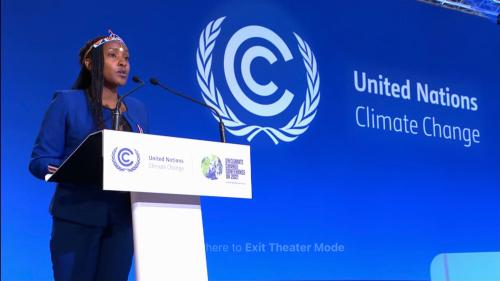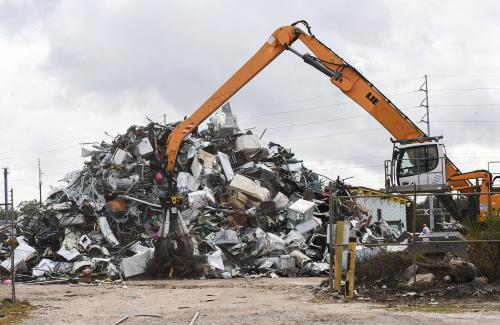The COP26 summit is now over and the question remains, where do we go from here?
Although progress has been made—a “big step forward” said U.K. Prime Minister Boris Johnson and perhaps even “a historic achievement” touted COP26 President Alok Sharma—we can now see, with stark clarity, the long road that lies ahead in restoring the safety of our planet.
The fundamental challenge is not the failure of particular nations or institutions or businesses or civil organizations, but rather the interaction between our economic, political, and social systems, which generates environmental outcomes that are incompatible with the 1.5 degrees Celsius target. Economic prosperity and political success have become decoupled from social and environmental prosperity.
The systemic nature of the problem is also commonly overlooked. Policymakers often think in terms of their ministerial silos. Business leaders often believe that they can address the problem on their own by pursuing stakeholder value. The business literature is full of inspiring stories of green businesses that represent “a ray of hope.” Investors address the problem on their own by decarbonizing their portfolios. Consumers try to change the world through environmentally responsible habits. The underlying reasoning is that “every little bit counts,” “every journey is taken one step at a time,” and “the whole is the sum of the parts.” While there may be value in this, we need to understand that, given the scale of the problem at hand, the whole may be greater than the sum of the parts.
Remarkably, we know what needs to be done to achieve collective mobilization, since we have observed what people do when they successfully achieve collective goals (such as establishing irrigation systems, maintaining groundwater basins, and protecting forests and fishing grounds). On this basis, the Nobel laureate Elinor Ostrom formulated eight core design principles (CDPs) for managing their commons, which have been generalized to all collective goods, such as emissions abatement. Let’s apply these principles to derive conditions for effective climate action.
Shared identity and purpose (CDP 1). Stopping global warming is an inherently global goal since greenhouse gases (GHGs) emitted anywhere affect people everywhere. Thus, we need to develop a sense of shared identity regarding this goal, as members of a common humanity striving to protect our planet. It should become a moral obligation of everyone—politicians, businesspeople, civilians—to stop global warming, similarly to the way we have come to consider the abolition of slavery a universal moral value.
COP26, along with the other international forums on climate action, is not engaged in promoting a shared identity and purpose with respect to climate action. Instead, national interests become naturally pitted against one another in the climate negotiations. This is not an unlucky coincidence; the structure of the negotiations—around national governments as the parties to the “Conference of the Parties” (COP)—makes this outcome inevitable. Nor do politicians within these countries aim to promote a shared human identity with respect to climate action.
Equitable distribution of costs and benefits (CDP 2). We know that if all countries and people of the world cooperated in climate action, in accordance with their abilities and needs, we and all future generations would be better off. But this possibility is not enough. Policymaking must ensure that the costs and benefits of climate action are actually distributed so as to make everyone better off. This principle should guide the climate negotiations between developed and developing countries, as well as the policymaking within each country.
But this principle is not the basis for the COP negotiations. On the contrary, there was predictable consternation when national interests were pursued to the detriment of others, such as when China and India watered down the wording of the Glasgow Climate Pact from “phasing out” coal to “phasing down” coal, or when the rich nations refused to pay for a standalone fund to help pay for damage from climate change in poor countries.
The same problem exists within countries. Most experts agree that efficient decarbonization would require a global carbon price aligned with the Paris Agreement. Since a ton of carbon emitted anywhere does the same damage to the environment, it makes sense for everyone to face the same carbon price. This would avoid the problem of “carbon leakage,” which occurs when carbon emission reductions in one country lead to increased carbon emissions in another country. The same holds for businesses. BlackRock chief Larry Fink called carbon leakage between public and private companies “the biggest capital markets arbitrage of my lifetime.”
But implementing a global carbon price—say, through carbon taxes or emission rights trading—may be socially unsustainable. The poor and middle classes may find it difficult to afford the resulting prices of carbon-intensive goods and services. The resulting employment decline of carbon-intensive sectors may leave workers without jobs and lead to the implosion of local communities. Though the resulting disempowerment and loss of social cohesion do not appear in our GDP statistics, they are nevertheless important costs of climate action. The COP26 negotiations have given them insufficient explicit attention.
Furthermore, global carbon pricing may undermine our intrinsic motivation. After all, if carbon emissions lead to natural destruction and death, then emitting carbon should be deemed immoral and carbon emissions should be pronounced illegal. In that case, fines—rather than taxes or emission right sales—would be more appropriate.
Next, successful climate action calls for fair and inclusive decisionmaking (CDP 3), so that all nations and social groups are involved in the decisions that affect them. For this purpose, we need a rejuvenation of participative democracy with regard to climate action. This does not mean that all nations and social groups need to make their decisions in consensus. There is room for a wide variety of decisionmaking rules—from qualified majorities to coalitions of the willing—so long as the relevant groups are involved in the rule-making process. The massive demonstrations at COP26 bear vivid witness that such a fair and inclusive process has not been achieved.
In fact, the most prominent crticism of the COP26 process from civil groups is the system’s exclusion of those arguably most affected by the impending climate catastrophe. Those in positions of power (characteristically the elderly, white, advantaged males) have a vested interest in keeping it that way. This means that those most affected—typically young people from developing countries and marginalized cultures—are disempowered, even though they frequently have the insight, local knowledge and, most of all, the sense of urgency that comes from the prospect of facing the most immediate consequences. COP26 is far from the fair and inclusive decisionmaking process that is called for.
Having agreed on the decisionmaking rules, successful climate action requires measurement and reporting of clear outcomes, year after year, permitting the monitoring of agreed-on actions (CDP 4) and graduated rewards for helpful actions and graduated sanctions for unhelpful ones (CDP 5).
Beyond that, the climate action process requires fast and fair conflict resolution mechanisms (CDP 6), with the help of trusted impartial mediators. The authority to self-govern (CDP 7), via the principle of subsidiarity, should be recognized at the supranational level, in all relevant international forums and organizations.
Finally, the successful implementation of the above principles will require polycentric governance (CDP 8), whereby multiple layers of governing bodies—at the international, national, regional, and local levels—interact to make and enforce agreements coherently. Thereby national policies remain in line with international agreements, and similarly for the subnational levels.
Needless to say, fulfilling all these requirements is a tall order, requiring systemic change. We cannot expect this to happen overnight. But what the people of the world—and our unborn generations—have a right to expect from us is that we try.
It is now high time to rise to the challenge of transforming our socio-political-economic system, with the aim of recoupling economic and political prosperity with social and environmental prosperity. In broad outline, we know what is to be done. Our natural world is not giving us much more time to do it.







Commentary
The climate conundrum
December 8, 2021